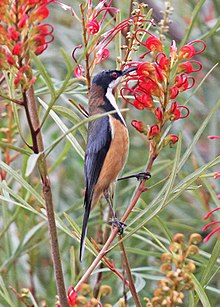Eastern spinebill
| Eastern spinebill | |
|---|---|

| |
| Male | |

| |
| Female | |
| Scientific classification | |
| Domain: | Eukaryota |
| Kingdom: | Animalia |
| Phylum: | Chordata |
| Class: | Aves |
| Order: | Passeriformes |
| Family: | Meliphagidae |
| Genus: | Acanthorhynchus |
| Species: | A. tenuirostris
|
| Binomial name | |
| Acanthorhynchus tenuirostris (Latham, 1801)
| |
| Subspecies | |
|
Acanthorhynchus tenuirostris cairnsensis | |
The eastern spinebill (Acanthorhynchus tenuirostris) is a species of honeyeater found in south-eastern Australia in forest and woodland areas, as well as gardens in urban areas of Canberra, Sydney, Melbourne, Adelaide and Hobart. It is around 15 cm long, and has a distinctive black, white and chestnut plumage, a red eye, and a long downcurved bill.
Taxonomy
Originally described as
The eastern spinebill forms a
Description

The male eastern spinebill is 13–16 cm (5–6.5 in) long, and has a long thin downcurved black bill with a black head, white throat with a chestnut patch and red iris.[8] It has a brownish-red nape, a grey-brown back and pale cinnamon underparts.[8] The dark tail is tipped with white laterally.[8] Females are smaller with olive-grey crown, similar in colouring to male but slightly duller; and juveniles are pale warm cinnamon below with grey to olive-brown upperparts, a brown-red eye and orange base to the bill.[9][8][10] The call is a clear, high-pitched, staccato piping "chip-chip-chip", sometimes repeated for lengthy periods.[11][8][9]
Distribution and habitat
Eastern spinebills are found in dry
Breeding
Breeding season is from August to January, with one or two broods raised. The nest is a deep
Diet
The eastern spinebill feeds on nectar from many plants, including the blooms of gum trees, mistletoes Amyema spp., Epacris longiflora,[13] Epacris impressa (common heath), Correa reflexa, and various members of the Proteaceae such as Banksia ericifolia,[14] Banksia integrifolia, Lambertia formosa and Grevillea speciosa, as well as small insects and other invertebrates. A 1982 study in the New England National Park in north-eastern New South Wales found that there was a large influx of birds coinciding with the start of flowering of Banksia spinulosa there.[13] They have been known to feed from exotic plants such as fuchsias.[15]
During periods of abundant flowering there may be periods of low nectar production, and it appears that the eastern spinebill responds to these periodic shortages by storing fat during periods of high nectar production, increasing the amount of time spent feeding, or dropping its day-time metabolic rate to night-time levels.[16]
References
Citations
- . Retrieved 12 November 2021.
- Leigh & Sotheby. p. xxxvi.
- Liddell, Henry George & Scott, Robert (1944) [1891]. Greek-English Lexicon (Abridged ed.). Oxford: Clarendon Press.
- ^ a b Higgins & Al-Dabbagh 2001, p. 1104.
- )
- ISBN 978-0-08-092499-1.
- ISBN 978-0-643-06511-6.
- ^ ISBN 978174021417-9
- ^ ISBN 0-670-90478-3.
- ISBN 085179813-6
- ^ ISBN 073222436-5
- ISBN 0-646-42798-9.
- ^ ISSN 0158-4197.
- .
- ^ Australian Museum (2006). "Bird Finder – Eastern Spinebill". Birds in Backyards. Australian Museum. Retrieved 2007-06-26.
- ISSN 0158-4197.
General and cited references
- Higgins, P.J.; Al-Dabbagh, K.Y. (2001). "Acanthorhynchus tenuirostris Eastern Spinebill". In Higgins, P.J.; Peter, J.M.; Steele, W.K. (eds.). Tyrant-flycatchers to Chats. Handbook of Australian, New Zealand and Antarctic Birds. Vol. 5. Oxford University Press. p. 1104. OCLC 46945690.
- "Acanthorhynchus tenuirostris (Latham, 1801)—Eastern Spinebill". Atlas of Living Australia.
External links
- Eastern spinebill at the Internet Bird Collection

